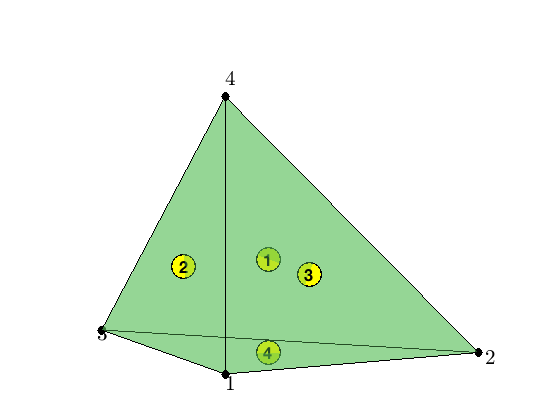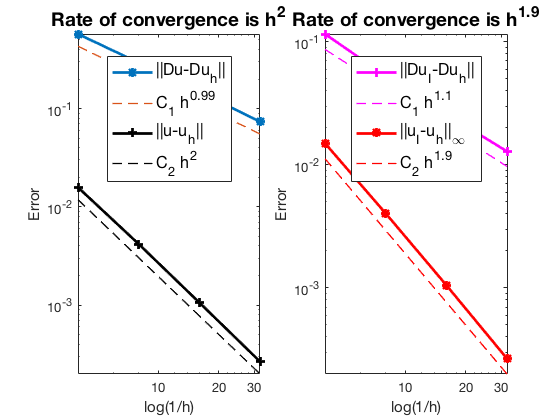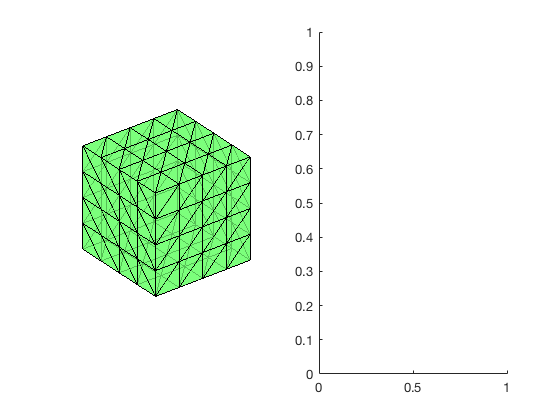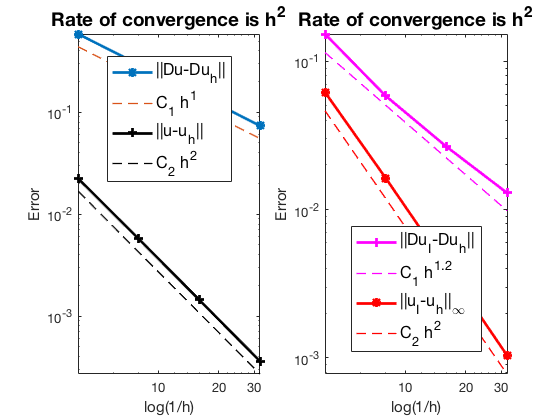CR Nonconforming Element for Poisson Equation in 3D
This example is to show the rate of convergence of the CR Nonconforming finite element approximation of the Poisson equation on the unit cube:
\[- \Delta u = f \; \hbox{in } (0,1)^3\]for the following boundary conditions
- Non-empty Dirichlet boundary condition: $u=g_D \hbox{ on }\Gamma_D, \nabla u\cdot n=g_N \hbox{ on }\Gamma_N.$
- Pure Neumann boundary condition: $\nabla u\cdot n=g_N \hbox{ on } \partial \Omega$.
- Robin boundary condition: $g_R u + \nabla u\cdot n=g_N \hbox{ on }\partial \Omega$.
References:
- Quick Introduction to Finite Element Methods
- Introduction to Finite Element Methods
- Progamming of Finite Element Methods
Subroutines:
- Poisson3CR
- cubePoisson
- femPoisson3
- Poisson3CRfemrate
The method is implemented in Poisson3CR subroutine and tested in cubePoissonCR. Together with other elements (P1,P2,Q1,WG,CR), femPoisson3 provides a concise interface to solve Poisson equation. The CR element is tested in Poisson3CRfemrate. This doc is based on Poisson3CRfemrate.
CR Nonconforming Element
We explain degree of freedoms and basis functions for Crouzeix-Raviart nonconforming P1 element on a tetrahedron. The dofs are associated to faces. Given a mesh, the required data structure can be constructured by
[elem2face,face] = dof3face(elem);
Local indexing
node = [0,0,0; 1,0,0; 0,1,0; 0,0,1];
elem = [1 2 3 4];
face = [2 3 4; 1 3 4; 1 2 4; 1 2 3];
showmesh3(node,elem); view([-26 10]);
findnode3(node);
findelem(node,face);

A Local Basis
The 4 Lagrange-type bases functions are denoted by $\phi_i, i=1:4$, i.e. $\phi_i(m_j)=\delta _{ij},i,j=1:4$, where $m_i$ is the center of the i-th face. In barycentric coordinates, they are:
\[\phi_i = 1- 2\lambda_i,\quad \nabla \phi_i = -2\nabla \lambda_i,\quad i =1:4.\]When transfer to the reference triangle formed by $(0,0,0),(1,0,0),(0,1,0),(0,0,1)$, the local bases in x-y-z coordinate can be obtained by substituting
\[\lambda _1 = x, \quad \lambda _2 = y, \quad \lambda _3 = z, \quad \lambda_4 = 1-x-y-z.\]Mixed boundary condition
%% Setting
[node,elem] = cubemesh([0,1,0,1,0,1],0.5);
mesh = struct('node',node,'elem',elem);
option.L0 = 1;
option.maxIt = 4;
option.elemType = 'CR';
option.printlevel = 1;
option.plotflag = 1;
%% Non-empty Dirichlet boundary condition.
pde = sincosdata3;
mesh.bdFlag = setboundary3(node,elem,'Dirichlet','~(x==0)','Neumann','x==0');
femPoisson3(mesh,pde,option);
Multigrid V-cycle Preconditioner with Conjugate Gradient Method
#dof: 6528, #nnz: 23040, smoothing: (1,1), iter: 17, err = 7.80e-09, time = 0.1 s
Multigrid V-cycle Preconditioner with Conjugate Gradient Method
#dof: 50688, #nnz: 190464, smoothing: (1,1), iter: 17, err = 9.10e-09, time = 0.25 s
Multigrid V-cycle Preconditioner with Conjugate Gradient Method
#dof: 399360, #nnz: 1548288, smoothing: (1,1), iter: 17, err = 9.78e-09, time = 2.6 s
Table: Error
#Dof h ||u-u_h|| ||Du-Du_h|| ||DuI-Du_h|| ||uI-u_h||_{max}
864 2.500e-01 1.57877e-02 5.75062e-01 1.15791e-01 1.49758e-02
6528 1.250e-01 4.18680e-03 2.93247e-01 5.28394e-02 4.03690e-03
50688 6.250e-02 1.06111e-03 1.47388e-01 2.58754e-02 1.05299e-03
399360 3.125e-02 2.66154e-04 7.37911e-02 1.28726e-02 2.66527e-04
Table: CPU time
#Dof Assemble Solve Error Mesh
864 1.10e-01 7.92e-03 1.00e-01 2.00e-02
6528 5.00e-02 1.02e-01 5.00e-02 1.00e-02
50688 2.10e-01 2.47e-01 2.10e-01 1.00e-01
399360 2.42e+00 2.60e+00 1.47e+00 0.00e+00


Pure Neumann boundary condition
When pure Neumann boundary condition is posed, i.e., $-\Delta u =f$ in $\Omega$ and $\nabla u\cdot n=g_N$ on $\partial \Omega$, the data should be consisitent in the sense that $\int_{\Omega} f \, dx + \int_{\partial \Omega} g \, ds = 0$. The solution is unique up to a constant. A post-process is applied such that the constraint $\int_{\Omega}u_h dx = 0$ is imposed.
%% Pure Neumann boundary condition.
option.plotflag = 0;
mesh.bdFlag = setboundary3(node,elem,'Neumann');
femPoisson3(mesh,pde,option);
Multigrid V-cycle Preconditioner with Conjugate Gradient Method
#dof: 6528, #nnz: 24957, smoothing: (1,1), iter: 20, err = 7.43e-09, time = 0.092 s
Multigrid V-cycle Preconditioner with Conjugate Gradient Method
#dof: 50688, #nnz: 198141, smoothing: (1,1), iter: 21, err = 4.01e-09, time = 0.24 s
Multigrid V-cycle Preconditioner with Conjugate Gradient Method
#dof: 399360, #nnz: 1579005, smoothing: (1,1), iter: 22, err = 4.23e-09, time = 2.7 s
Table: Error
#Dof h ||u-u_h|| ||Du-Du_h|| ||DuI-Du_h|| ||uI-u_h||_{max}
864 2.500e-01 2.24448e-02 5.86299e-01 1.53064e-01 6.19341e-02
6528 1.250e-01 5.72292e-03 2.94670e-01 5.84934e-02 1.63182e-02
50688 6.250e-02 1.43932e-03 1.47567e-01 2.66183e-02 4.13880e-03
399360 3.125e-02 3.60390e-04 7.38135e-02 1.29661e-02 1.03857e-03
Table: CPU time
#Dof Assemble Solve Error Mesh
864 4.00e-02 1.86e-03 2.00e-02 1.00e-02
6528 3.00e-02 9.16e-02 3.00e-02 1.00e-02
50688 2.10e-01 2.37e-01 1.30e-01 7.00e-02
399360 2.74e+00 2.70e+00 1.41e+00 0.00e+00

Robin boundary condition
%% Pure Robin boundary condition.
pde = sincosRobindata3;
mesh.bdFlag = setboundary3(node,elem,'Robin');
femPoisson3(mesh,pde,option);
Multigrid V-cycle Preconditioner with Conjugate Gradient Method
#dof: 6528, #nnz: 24960, smoothing: (1,1), iter: 17, err = 3.83e-09, time = 0.074 s
Multigrid V-cycle Preconditioner with Conjugate Gradient Method
#dof: 50688, #nnz: 198144, smoothing: (1,1), iter: 17, err = 7.40e-09, time = 0.31 s
Multigrid V-cycle Preconditioner with Conjugate Gradient Method
#dof: 399360, #nnz: 1579008, smoothing: (1,1), iter: 17, err = 7.34e-09, time = 3 s
Table: Error
#Dof h ||u-u_h|| ||Du-Du_h|| ||DuI-Du_h|| ||uI-u_h||_{max}
864 2.500e-01 1.70968e-02 5.78078e-01 1.24451e-01 2.87371e-02
6528 1.250e-01 4.51894e-03 2.93659e-01 5.40040e-02 7.24170e-03
50688 6.250e-02 1.14572e-03 1.47441e-01 2.60230e-02 1.82017e-03
399360 3.125e-02 2.87439e-04 7.37977e-02 1.28910e-02 4.57164e-04
Table: CPU time
#Dof Assemble Solve Error Mesh
864 5.00e-02 9.15e-04 0.00e+00 0.00e+00
6528 3.00e-02 7.44e-02 2.00e-02 1.00e-02
50688 2.00e-01 3.09e-01 1.70e-01 7.00e-02
399360 2.16e+00 3.05e+00 1.48e+00 0.00e+00

Conclusion
The optimal rate of convergence of the H1-norm (1st order) and L2-norm (2nd order) is observed. No superconvergence for $|\nabla u_I - \nabla u_h|$.
MGCG converges uniformly in all cases.
Comments